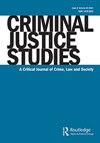警察随身携带的摄像镜头:对公众观看权和警察沟通的态度
IF 1.1
Q3 OPERATIONS RESEARCH & MANAGEMENT SCIENCE
引用次数: 0
摘要
摘要本研究的目的是进一步了解影响公民对公众有权观看《生物武器公约》重大事件录像以及事后警方沟通的因素。为了实现这一点,我们使用了 × 2个小插曲,公民种族和对象被操纵到不同的条件。使用一份发给亚马逊Mturk员工的调查工具,发现了一些与人口统计和媒体对公众观看视频权利的看法有关的显著发现。白人受访者更有可能认为公众应该能够观看黑人嫌疑人手持手机的视频,而白人受访者则不太可能相信公众应该能够看到黑人嫌疑人手持手枪的视频。在其他几段重要关系中,年龄与支持警方在与一名拿着手机的黑人嫌疑人的场景中加强沟通呈正相关。随着媒体敌意的增加,受访者不太可能支持警方加强沟通。对媒体敌意的看法一直影响着受访者对公众有权观看《生物武器公约》录像和警方沟通的看法。本文章由计算机程序翻译,如有差异,请以英文原文为准。
Police body-worn camera footage: Attitudes toward the public right to view and police communication
ABSTRACT The aim of this study is to learn more about the factors that influence citizen perceptions of the public right to view BWC footage of a critical incident as well as police communication afterwards. To accomplish this, we used a 2 × 2 vignette where citizen race and object were manipulated to different conditions. Using a survey instrument sent to Amazon Mturk workers, several notable findings related to demographic and media perceptions were found regarding the public’s right to view the footage. White respondents were more likely to believe that the public should be able to view the footage involving the Black suspect holding a cellphone, whereas White respondents were less likely to believe that the public should be able to view the footage involving a Black suspect holding a handgun. Age was positively related to supporting increased communication from police for the scenario with a Black suspect with a cellphone,among several other significant relationships. As media hostility increased, respondents were less likely to support increased communication from the police. Perceptions of media hostility consistently influenced respondent perceptions of the public’s right to view BWC footage and police communication across all manipulations.
求助全文
通过发布文献求助,成功后即可免费获取论文全文。
去求助
来源期刊

CRIMINAL JUSTICE STUDIES
OPERATIONS RESEARCH & MANAGEMENT SCIENCE-
CiteScore
2.80
自引率
5.60%
发文量
17
期刊介绍:
Criminal Justice Studies, a quarterly refereed journal, publishes articles that deal with substantive criminal justice and criminological issues. The journal welcomes all articles that are relevant to the issue of criminal justice, as well as those that may be outside the field but have relevancy to the topic of criminal justice. Articles that cover public administration, issues of public policy, as well as public affairs issues are welcome. The journal also publishes relevant literature reviews, research notes and summary reports of innovative research projects in criminal justice. Qualitative and quantifiable articles are sought mainly from academics and researchers in the field, though articles from professionals will also be considered.
 求助内容:
求助内容: 应助结果提醒方式:
应助结果提醒方式:


